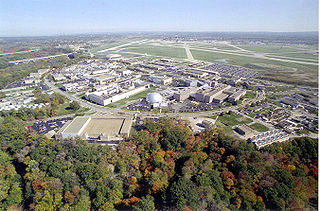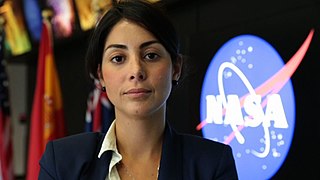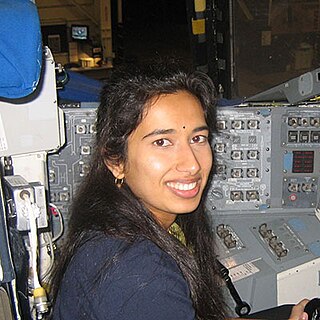Related Research Articles

NASA John H. Glenn Research Center at Lewis Field is a NASA center within the cities of Brook Park and Cleveland between Cleveland Hopkins International Airport and the Rocky River Reservation of Cleveland Metroparks, with a subsidiary facility in Sandusky, Ohio. Its director is James A. Kenyon. Glenn Research Center is one of ten major NASA facilities, whose primary mission is to develop science and technology for use in aeronautics and space. As of May 2012, it employed about 1,650 civil servants and 1,850 support contractors on or near its site.

The USC Viterbi School of Engineering is the engineering school of the University of Southern California. It was renamed following a $52 million donation by Andrew J. Viterbi, co-founder of Qualcomm.

Norman Earl Thagard is an American scientist and former U.S. Marine Corps officer and naval aviator and NASA astronaut. He is the first American to ride to space on board a Russian vehicle, and can be considered the first American cosmonaut. He did this on March 14, 1995, in the Soyuz TM-21 spacecraft for the Russian Mir-18 mission.

Bonnie Jeanne Dunbar is an American engineer and retired NASA astronaut. She flew on five Space Shuttle missions between 1985 and 1998, including two dockings with the Mir space station.

George David Low was an American aerospace executive and a NASA astronaut. With undergraduate degrees in physics and mechanical engineering and a master's degree in aeronautics and astronautics, he worked in the Jet Propulsion Laboratory (JPL) at the California Institute of Technology in the early 80's, before being picked as an astronaut candidate by NASA in 1984. In addition to holding some technical assignments, he logged more than 700 hours in space, before he left NASA in 1996 to pursue a career in the private sector. He was the son of George M. Low, the manager of the Apollo Spacecraft Program Office, and later, the 14th president of Rensselaer Polytechnic Institute.

Gregory Thomas Linteris is an American scientist who flew as a payload specialist on two NASA Space Shuttle missions in 1997.

Eugene Huu-Chau "Gene" Trinh is a Vietnamese American biochemist who flew aboard NASA Space Shuttle mission STS-50 as a Payload Specialist, becoming the first Vietnamese American astronaut in space and the second Vietnamese in space.

Gary Arnold Flandro is an American aerospace engineer who is currently the professor for the Boling Chair of Excellence in Space Propulsion (Emeritus) at the University of Tennessee Space Institute. He is also the Vice President and Chief Engineer for Gloyer-Taylor Laboratories (GTL).

Donna Lee Shirley is a former manager of Mars Exploration at the NASA Jet Propulsion Laboratory. She is the author of the book Managing Martians: The Extraordinary Story of a Woman's Lifelong Quest to Get to Mars—and of the Team Behind the Space Robot That Has Captured the Imagination of the World.

Adam Diedrich Steltzner is an American NASA engineer who works for the Jet Propulsion Laboratory (JPL). He worked on several flight projects including Galileo, Cassini, Mars Pathfinder, Mars Exploration Rovers (MER). He was the lead engineer of the Mars Science Laboratory's EDL phase, and helped design, build and test the sky crane landing system.

Bobak Ferdowsi is a flight engineer at NASA's Jet Propulsion Laboratory. He served on the Cassini–Huygens and Mars Science Laboratory Curiosity missions.

The Cold Atom Laboratory (CAL) is an experimental instrument on board the ISS, which launched in 2018. It creates an extremely cold environment in microgravity in order to study behaviour of atoms in these conditions.

Michael M. Watkins is an American engineer, scientist, and a Professor of Aerospace and Geophysics at the California Institute of Technology (Caltech). He previously served as the 9th director of NASA's Jet Propulsion Laboratory in Pasadena, California, and as a vice president of Caltech, which staffs and manages JPL for NASA. His directorial position was effective from July 1, 2016 to August 20, 2021.

Lady Diana Trujillo Pomerantz is a Colombian-American aerospace engineer at the NASA Jet Propulsion Laboratory. She currently leads the engineering team at JPL responsible for the robotic arm of the Perseverance rover. On February 18, 2021, Trujillo hosted the first ever Spanish-language NASA transmission of a planetary landing, for the Perseverance rover landing on Mars.

Farah Alibay is a Canadian systems engineer at the NASA Jet Propulsion Laboratory who has worked on the InSight, Mars Cube One, and Mars 2020 missions.

Vandana "Vandi" Verma is a space roboticist and chief engineer at NASA's Jet Propulsion Laboratory, known for driving the Mars rovers, notably Curiosity and Perseverance, using software including PLEXIL programming technology that she co-wrote and developed.
The Ann and H.J. Smead Department of Aerospace Engineering Sciences is a department within the College of Engineering & Applied Science at the University of Colorado Boulder, providing aerospace education and research. Housed primarily in the Aerospace Engineering Sciences building on the university's East Campus in Boulder, it awards baccalaureate, masters, and PhD degrees, as well as certificates, graduating approximately 225 students annually. The Ann and H.J. Smead Department of Aerospace Engineering Sciences is ranked 10th in the nation in both undergraduate and graduate aerospace engineering education among public universities by US News & World Report.

Swati Mohan is an Indian-American aerospace engineer and was the Guidance and Controls Operations Lead on the NASA Mars 2020 mission.
Andrea P. Belz is an American innovation engineer, academic and author. She is a Professor of Practice in Industrial and Systems Engineering and the Vice Dean of Transformative Initiatives in the Viterbi School of Engineering at the University of Southern California (USC).
Christina Hernández is a Mexican-American systems engineer at NASA. She was involved in STEM programs, which led her to a career in NASA where she has worked on the Mars Perseverance Rover, along with being a micrometeoroid and orbital debris specialist at the Jet Propulsion Laboratory. Her contribution to aerospace involved adding safety within spacecraft. Also as an advocate for Latinas in STEM, Hernandez was a recipient of the Hispanic Heritage Foundation awards in 2021.
References
- 1 2 3 "Cold Atom Laboratory:People". Jet Propulsion Laboratory. Caltech. Archived from the original on 29 March 2013. Retrieved 12 December 2014.
- ↑ "Curiosity's Seven Minutes of Terror". NASA.gov. June 22, 2012. Retrieved August 6, 2012.
- ↑ "Deep Space 1". NASA.gov. June 22, 2012. Retrieved August 6, 2012.
- ↑ "Ion Propulsion". jpl.nasa.gov. September 3, 2002. Retrieved August 6, 2012.
- ↑ "AIAA award". Jet Propulsion Laboratory. USC. Retrieved 10 June 2005.
- ↑ WYSK (August 27, 2012). "Women Talk: 10+ Questions With Rocket Scientist, Dr. Anita Sengupta". Women You Should Know. Retrieved April 3, 2015.
- ↑ "Landing a rover was career highlight, says Anita Sengupta". The Hindu. August 21, 2013. Retrieved April 3, 2015.
- ↑ Andy Meek. "What It's Like To Be One Of The Few Female Aerospace Engineers". Fast Company. Retrieved April 3, 2015.
- ↑ "NASA-JPL Systems Engineer and Viterbi School Alumna on Early Influences and Designing Curiosity's Parachute". USC - Viterbi School of Engineering. Retrieved 12 December 2014.
- ↑ "Team | Hyperloop One". 2018-10-20. Archived from the original on 2018-10-20. Retrieved 2019-03-07.
- ↑ "ASX team". Archived from the original on 2019-03-07. Retrieved 2019-03-07.
- ↑ "Soft Mars landing thanks to engineer from Bishopbriggs". HeraldScotland. 3 September 2012. Retrieved 2019-02-26.
- ↑ "At home in space - Scientist hooked on Spock as 6-year-old". www.telegraphindia.com. Retrieved 2019-02-26.